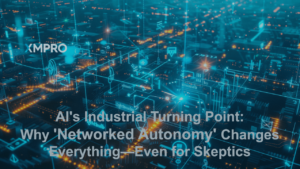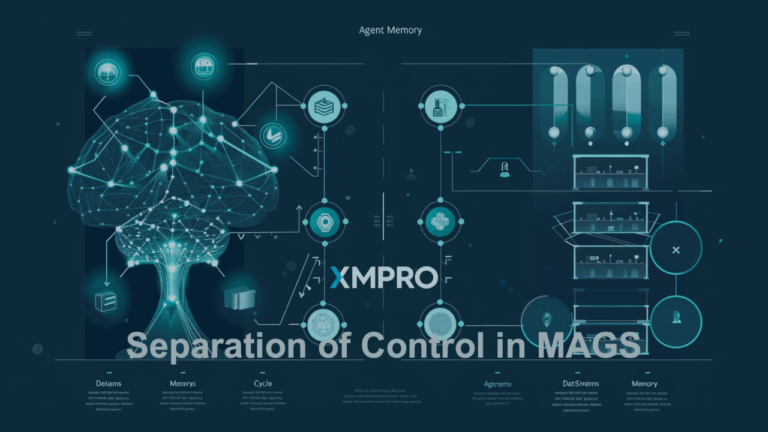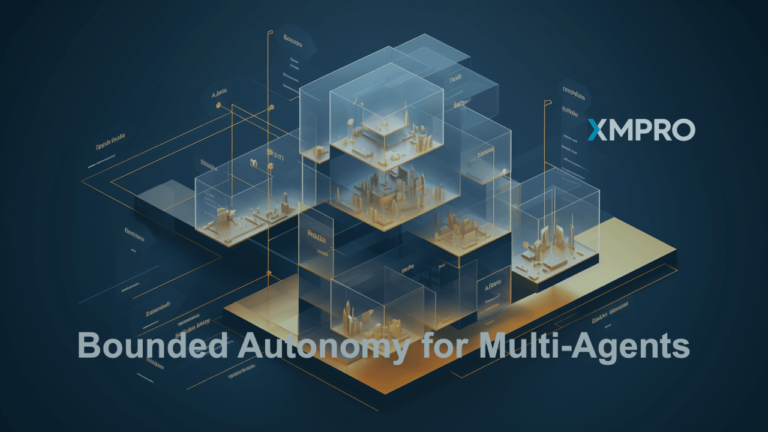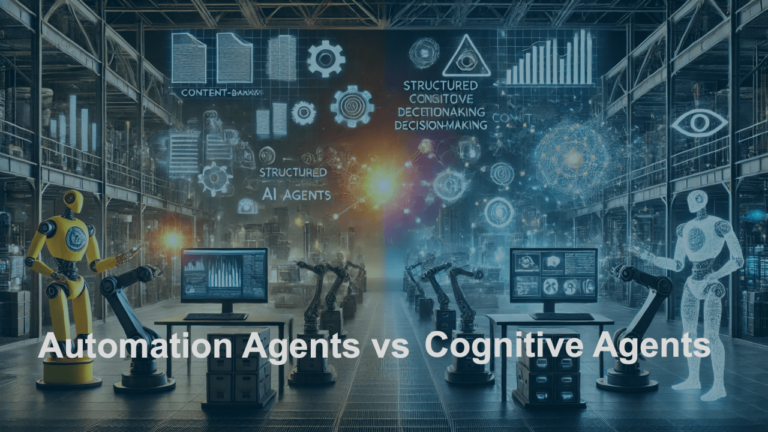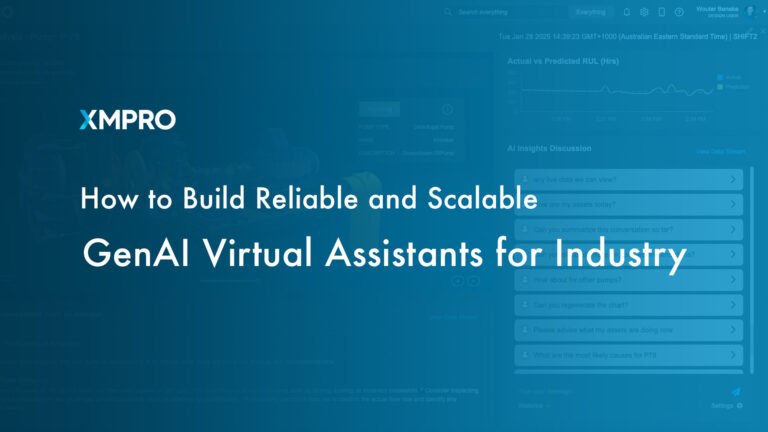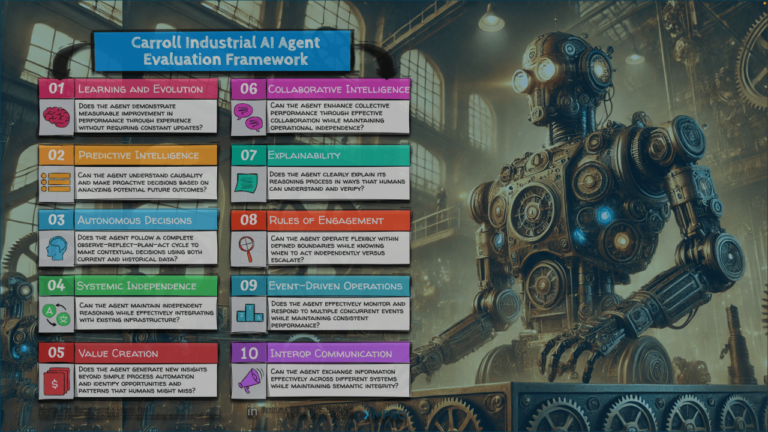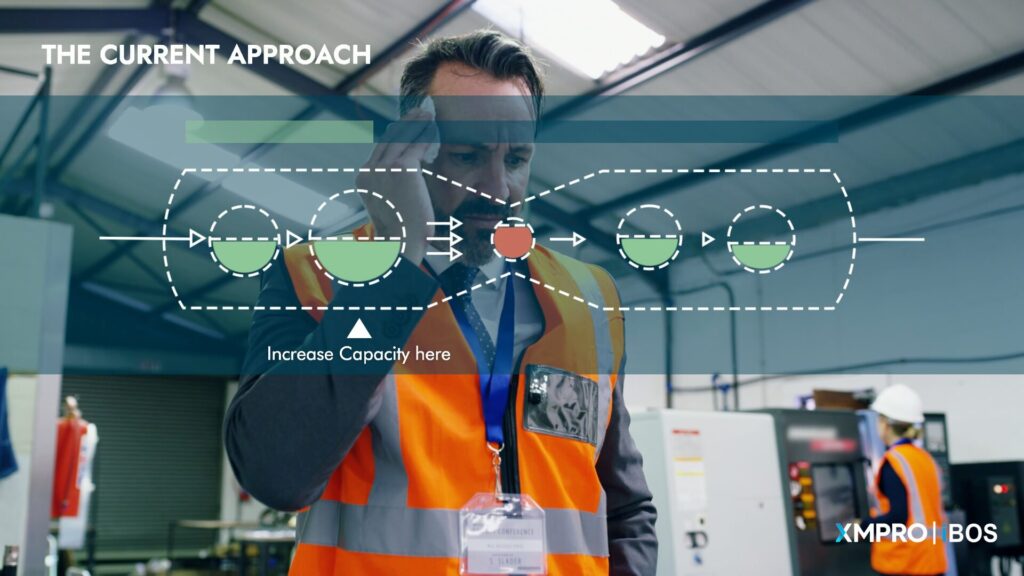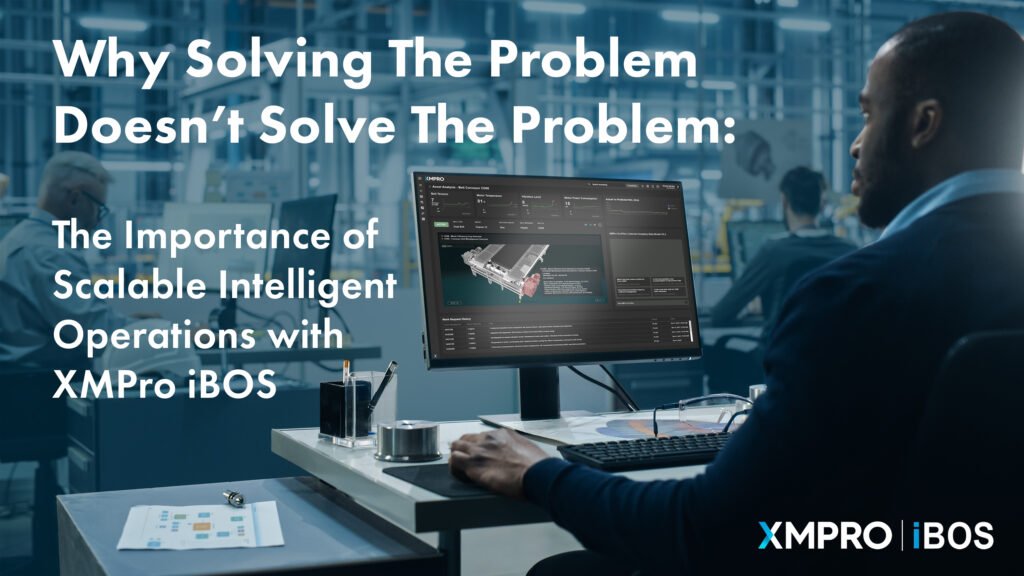
Why Solving the Problem Doesn’t Solve the Problem:
The Importance of Scalable Intelligent Operations with XMPro iBOS
Introduction
In today’s fast-paced industrial landscape, companies are under immense pressure to optimize operations and drive efficiency. The demand for real-time insights, seamless integration, and scalable solutions has never been more critical.

The Challenge:
Industrial companies need to build new Intelligent Operations and Process Solutions to address a variety of needs such as Condition Monitoring, Predictive Maintenance, Process Optimization, Asset Performance Management (APM), Asset Health, Golden Batch production and more.

They must manage vast amounts of data from various sources, ensure timely and accurate decision-making, and maintain a competitive edge in a rapidly evolving market.
However, achieving these goals is far from straightforward. The complexity of modern industrial operations often results in siloed data, fragmented processes, and a lack of real-time visibility. These issues hinder the ability to make informed decisions and optimize operations effectively.
Outdated Approaches:
Many businesses still rely heavily on manual, rule-based systems for their operational processes. These traditional methods lead to operational inefficiencies, limited insights, and a competitive disadvantage. The skills shortage in the industry further exacerbates these problems, making it clear that sticking with outdated processes is unsustainable.

Additional Challenges:
- Data Overload: Managing and analyzing massive amounts of data without the right tools.
- Integration Issues: Complex and time-consuming integration of data from various sources and systems.
- Real-Time Processing: Struggling to achieve real-time data processing and analytics for timely decision-making.
- Scalability: Ensuring solutions can scale as companies grow.
- Security Concerns: Protecting sensitive data and ensuring cybersecurity.
- Regulatory Compliance: Adhering to industry regulations and standards.
- Operational Downtime: Minimizing unplanned downtime with predictive maintenance.
- Energy Efficiency: Improving energy efficiency and reducing environmental impact.
- IT-OT Disconnect: Bridging the gap between Information Technology (IT) and Operational Technology (OT) systems to ensure seamless data flow and unified operations.
The Need for Change:
It is evident that companies need a new approach—one that not only addresses immediate operational needs but also provides a scalable, unified framework for long-term success. The complexity and scale of modern industrial challenges demand solutions that integrate advanced AI, automation, and digital twins to empower rapid digital transformation and maintain a competitive edge.
By understanding these market insights and the inherent challenges, businesses can better appreciate the need for innovative solutions designed to transform industrial operations with intelligent, scalable, and integrated processes.
Alternative Approaches
To tackle these challenges, many companies rely on point solutions and specialist consultants to build bespoke systems tailored to specific operational needs. These custom solutions are often designed to address immediate issues, but they come with inherent limitations.

One of the primary challenges is the Theory of Constraints. As these bespoke solutions are developed, they frequently solve one bottleneck, only to reveal a new one, potentially leading to even worse performance if the new bottleneck is not addressed. For example, in the mining industry, a company might deploy an advanced predictive maintenance tool to monitor the health of conveyor belts. This tool can predict when a conveyor belt is likely to fail, allowing maintenance to be scheduled proactively, thereby reducing unplanned downtime. However, as the predictive maintenance tool optimizes conveyor belt performance and increases their capacity, a new bottleneck is revealed at the hoists. The hoists, which are not integrated with the predictive maintenance system, become the next point of failure as they cannot handle the increased load from the conveyors. This lack of integration results in fragmented data and disjointed processes, making it difficult to achieve a holistic view of operations and causing new inefficiencies to emerge.
Moreover, as new solutions are required, the problem intensifies. Each new system, whether for process optimization, OEE tracking, or environmental monitoring, is typically built independently and lacks interoperability with existing tools. This creates a complex web of disconnected systems that fail to provide cohesive operational insights. Over time, maintaining and scaling these disparate solutions becomes increasingly challenging and expensive.
The complexity of managing these fragmented solutions often results in skyrocketing costs. Many man-hours are spent on building and manually integrating bespoke systems, leading to significant financial burdens. The continuous need for customization and manual updates further increases operational costs and resource allocation, diverting attention from strategic initiatives.
The disconnect between IT and OT systems further complicates the situation. IT focuses on data processing and cybersecurity, while OT is concerned with physical processes and machinery. This separation can lead to integration challenges, data silos, inconsistent insights, and operational delays, making it difficult to achieve unified, real-time operational visibility.
The current approach to building operational and business process solutions is fundamentally flawed. Companies are forced to piece together point solutions and bespoke systems, leading to inefficiencies and a fragmented view of their operations. The reliance on manual, rule-based systems further exacerbates these issues, causing operational inefficiencies and limiting insights. This results in a competitive disadvantage as companies struggle to keep up with more modernized competitors.
The Need for a Unified Approach:
What is needed is a comprehensive, integrated framework that can seamlessly unify these solutions. It also needs to provide the tools and capabilities for SMEs and consultants to build and compose these solutions in a scalable, integrated, and composable way. XMPro addresses these needs by offering a unified approach that supports both the integration of existing tools and the development of new, intelligent solutions. Our platform enables businesses to transition from outdated, manual processes to advanced, AI-driven operations that are efficient, insightful, and highly integrated.
In the Perfect World
Imagine a perfect world where your operations are seamlessly integrated, and all your data flows freely across systems, providing real-time insights and a unified view of your business. In this ideal scenario, companies can rapidly advance in their digital transformation journey.
Operations are enhanced with advanced analytics, AI, and machine learning, enabling proactive decision-making and predictive maintenance. Companies can anticipate issues before they arise, optimize processes continuously, and make data-driven decisions that improve strategic planning and operational effectiveness.
Automation reaches new heights, streamlining workflows and reducing manual intervention. Companies achieve significant efficiency gains, from individual assets to entire factories and enterprise systems. Automation ensures consistent, high-quality outputs and frees up human resources for more strategic tasks.
Solutions expand from individual assets to entire systems of systems, creating comprehensive digital twins that offer unparalleled visibility and control over every aspect of operations. This integrated approach ensures that all processes, from simple to complex, are managed effectively and efficiently, providing a holistic view of the entire operation.
Silos and fragmentation are eliminated, allowing for seamless integration and optimized processes. Companies can rapidly compose intelligent operations and process solutions that scale with their business needs. Whether deployed on-premise, in the cloud, or using a hybrid approach, XMPro ensures flexibility. Data streams can even run on the edge for real-time analysis, ensuring timely and actionable insights.
In this perfect world, companies leverage XMPro’s Co-Pilot and GenAI capabilities to interrogate real-time data and perform in-depth analysis. These advanced tools provide immediate insights, enabling businesses to respond swiftly to operational changes and make informed decisions with confidence.
In this perfect world, companies experience enhanced operational efficiency, reduced downtime, increased productivity, and improved competitiveness. They can respond swiftly to market changes, regulatory demands, and customer needs, ensuring sustained growth and success in a rapidly evolving industrial landscape.
Introducing XMPro
Introducing XMPro iBOS, the world’s only AI-powered suite of tools and framework designed to rapidly compose integrated and intelligent business operations and process solutions at scale.
XMPro iBOS addresses the challenges of modern industrial operations by offering a scalable, integrated, and composable framework. With XMPro, you can rapidly build and deploy intelligent operations and process solutions. Our platform enables seamless integration of data from various sources, providing real-time insights and a unified view of your operations.
Advanced Analytics and AI:
XMPro enhances the intelligence of your operations through advanced analytics and AI. Our platform leverages machine learning, predictive analytics, and generative agents to enable proactive decision-making, anomaly detection, and predictive maintenance. By embedding AI into real-time data streams, XMPro allows you to anticipate and respond to operational challenges before they escalate.
Automation Capabilities:
Our automation capabilities streamline workflows and reduce manual intervention, leading to significant efficiency gains. XMPro supports event-driven automation and integrates seamlessly with robotic process automation (RPA) technologies, allowing you to automate routine tasks and focus on strategic initiatives.
Digital Twin Capabilities:
Additionally, XMPro expands the scope of your digital solutions from individual assets to entire systems of systems. Our digital twin capabilities provide comprehensive digital representations of physical assets and systems, enabling real-time monitoring, simulation, and optimization. This holistic view offers unparalleled visibility and control over every aspect of your operations.
Flexible Deployment:
XMPro can be deployed on-premise, in the cloud, or as a hybrid solution. This flexibility ensures that you can choose the deployment model that best fits your business needs. Moreover, data streams can run on the edge for real-time analysis, providing timely and actionable insights directly where they are needed most.
Co-Pilot and GenAI Capabilities:
XMPro’s Co-Pilot and GenAI capabilities enable users to interrogate real-time data and perform in-depth analysis effortlessly. These tools provide immediate, actionable insights and recommendations, empowering users to make informed decisions and optimize operations continuously.
Key Benefits:
By leveraging XMPro iBOS, companies can achieve rapid digital transformation, improving operational intelligence, automation, and the scope of their solutions, all within a unified, scalable framework. This transformative approach ensures that businesses remain competitive and thrive in a rapidly evolving industrial landscape.
How Does XMPro Enable Scalable Intelligent Operations?
XMPro iBOS stands out by offering a suite of foundational capabilities that are underpinned by a framework that is trustworthy, secure, integrated, interoperable, real-time, and event-driven. These features form the bedrock of our platform, ensuring that your operations are built on a reliable and robust framework.
Digital Transformation Across Three Critical Dimensions:
Let’s have a look at this use case matrix to illustrate how XMPro empowers companies to grow across three critical dimensions: Intelligence, Automation, and Digital Twin Scope.
1.Intelligence:
The first axis, Intelligence, spans from rule-based systems to advanced AI and generative AI. XMPro’s AI capabilities bring intelligence to solution building by leveraging machine learning, natural language processing, and predictive analytics. The three levels of intelligence include the following:
- Rule-Based Systems: These are foundational systems that follow predefined rules and logic to provide basic automation and decision-making.
- Augmented AI: This level involves embedding AI models and algorithms into processes to enhance decision-making with real-time data and predictive analytics. It provides deeper insights and supports more complex decision-making scenarios.
- Generative Agents: The highest level, incorporating advanced AI and machine learning models, including generative AI. These agents provide proactive recommendations, anomaly detection, and predictive maintenance, ensuring optimal operational performance.
Key modules that enhance intelligence include the following:
- Data Stream Designer: Facilitates real-time data processing, allowing for scalable model management and MLOps by embedding models into the data stream. This can include in-house models running on-premise or cloud-based models such as OpenAI GPT variants, enhancing the overall intelligence of operations. This tool also supports granular rule-based recommendations and anomaly detection.
- XMPro AI: Leverages machine learning and predictive analytics to enable proactive decision-making, anomaly detection, and predictive maintenance. Features include embedded AI, generative AI, and augmented AI, providing real-time context and insights for decision-making and process optimization.
- App Designer: Visually displays data from various sources as integrated and orchestrated within data streams, supporting comprehensive decision-making and enhancing the intelligence of operations. It features the Co-Pilot capability, which allows users to interrogate real-time data from assets and create custom real-time reports. The Co-Pilot can also notify plant managers of anomalies and predictive insights.
- Recommendation Manager: Provides actionable insights and AI-generated predictive recommendation alerts that are intelligently ranked and actioned by criticality scoring. Recommendations can be triggered by large language models (LLMs) that poll and scan real-time data and results from anomaly detection and machine learning models. This capability is crucial for maintaining operational efficiency and effectiveness by providing timely, data-driven recommendations.
2.Automation:
The second axis, Automation, covers everything from human workflows to event streams and robotic process automation (RPA), culminating in fully autonomous operations. The three levels of automation include the following:
- Basic Automation: This level includes simple rule-based automation for routine tasks, where human decision-making is still necessary within the workflow, reducing manual intervention and increasing efficiency.
- Process Automation: Involves automating complex processes and workflows, integrating with various systems to streamline operations and improve efficiency.
- Autonomous Operations: The highest level of automation, where advanced AI and machine learning drive fully autonomous operations, minimizing human intervention and optimizing processes in real-time.
Key modules that drive automation include the following:
- Data Stream Designer: Enables real-time data processing and automation of routine tasks, automating data collection, analysis, and response mechanisms. It supports event-driven automation and seamless integration with various data sources, allowing for efficient and streamlined operations.
- XMPro AI: Embeds AI models within data streams to automate decision-making processes and operational workflows, reducing manual intervention. It provides advanced analytics and predictive insights to support automated responses and optimization.
- App Designer: Allows users to create custom applications that automate workflows and streamline operations with a drag-and-drop interface for easy deployment of intelligent applications. It enables the visualization of automated processes and real-time monitoring of operations.
- Recommendation Manager: Uses AI logic and business rules to offer prescriptive recommendations, ensuring continuous process improvement and operational efficiency. It provides real-time recommendations and alerts based on data analysis, helping to automate decision-making and optimize processes.
3.Digital Twin Scope:
The third axis, Digital Twin Scope, ranges from discrete entities to aggregated and complex entities. The three levels of digital twin scope include the following:
- Discrete Entity: Digital representations of individual assets, providing visibility and control over their operations.
- Aggregated Entity: Digital twins of combined assets, like a haul truck, enabling the monitoring and optimization of interconnected systems.
- Complex Entities: Comprehensive digital twins of entire systems, offering a holistic view of complex operations and facilitating advanced simulation and optimization.
Key modules that enhance digital twin capabilities include the following:
- Data Stream Designer: Manages real-time data streams from various sources, ensuring accurate and up-to-date digital representations of physical assets. Deployed by use case, it can be used across thousands of the same asset. Clients have seen great success by starting on use cases at the operational level, focusing on discrete assets where the business solution would have a high impact, then scaling out quickly to tactical solutions and finally strategic solutions. As companies build out datastreams per use case within a discrete asset or component, it is easy to integrate these datastreams into a composite digital twin. The same applies to systems of systems.
- XMPro AI: Integrates AI models into these systems, ensuring continuous improvement and scalability from individual assets to entire interconnected systems. With MLOps and flexibility in model training, including TS foundation model utilization, XMPro AI facilitates rapid AI solution deployment.
- App Designer: A no-code UI builder that allows companies to rapidly build integrated interfaces for their solutions at operational, tactical, and strategic levels. This flexibility ensures that solutions can easily and flexibly scale from discrete digital twins to systems of systems.
- Recommendation Manager: Increases scope by allowing sophisticated scoring rules for importance and criticality. Recommendations can be turned into actions that close the loop on event response, including work orders, notifications through email, SMS, collaboration software such as Microsoft Teams, ERP systems, and more. This scales from simple recommendations for a single asset to complex strategic-level views of entire systems of systems, ensuring the most critical recommendation alerts reach the correct employee or team for action.
Only XMPro enables companies to advance simultaneously across these three dimensions, providing a flexible and scalable framework that adapts to your evolving needs. By integrating intelligence, automation, and digital twin capabilities, XMPro delivers a unified solution that drives rapid digital transformation, optimizes processes, and fosters a comprehensive understanding of your business operations.
XMPro iBOS offers flexible deployment options, whether on-premise, in the cloud, or as a hybrid solution. This flexibility allows you to choose the deployment model that best fits your business needs. Additionally, data streams can run on the edge for real-time analysis, ensuring timely and actionable insights.
XMPro’s Co-Pilot and GenAI capabilities enable users to interrogate real-time data and perform in-depth analysis effortlessly. These tools provide immediate, actionable insights and recommendations, empowering users to make informed decisions and optimize operations continuously.
By advancing across intelligence, automation, and digital twin scope, XMPro iBOS provides a unified, scalable framework that ensures your business remains competitive and thrives in a rapidly evolving market.
Case Studies: Successful Implementations of XMPro iBOS

1. $4M Saved – Predictive Maintenance for Underground Long Conveyor
In this project, the challenge was to reduce the downtime of underground conveyors by 30%. XMPro introduced intelligence through real-time data monitoring and predictive analytics, monitoring 52 conveyors over 80 km. Automation was achieved by integrating with OSIsoft Historian and Oracle EAM, allowing complex engineering models to execute at 2-second intervals. The scope expanded from monitoring discrete assets (individual conveyors) to a composite digital twin of the entire conveyor system. This comprehensive monitoring and predictive maintenance strategy led to:
- Preventing approximately 184 hours of downtime.
- Identifying 44k tonnes of product worth $4M.
- Achieving a 30% reduction in downtime.
Expansion: The success with conveyors allowed the company to scale their use cases, applying the same principles to other assets such as borers, crushers, pumps, fans, and overall management OEE, generating 72 million messages a day.
Measures of Success:
- Time to Value: 30 days to deploy initial release, integration with OSIsoft Historian and Oracle EAM, and execution of complex engineering models at 2-second intervals.
- Always On, Situational Awareness: Monitoring and analysis of 52 long conveyors every 2 seconds, real-time dashboards for decision support and automation.
- Expert Knowledge Capture: Continuous analysis and recommendations integrated into predictive maintenance processes.
Benefits:
- Intelligence: Real-time monitoring and predictive analytics.
- Automation: Integration with existing systems and automated alerting.
- Scope: From individual conveyors to an interconnected system of various assets.
- Financial Impact: $4M in additional revenue due to reduced downtime.

2. $8M Savings in First 6 Months
This project aimed to increase the predictability of asset operations. XMPro enhanced intelligence by integrating disparate data and systems with field service maintenance, improving data-based decision-making. Automation was introduced to reduce truck rolls and improve asset utilization, with an 18% reduction in field service trips. The scope expanded from discrete assets to a strategic level view of operations.
The project resulted in:
- $8M in documented savings in 6 months.
- Achieving break-even in less than 4 weeks.
- Improved asset integrity and utilization.
Measures of Success:
- Time to Value: 3 months to deploy initial release, addressing data integrity issues, achieving break-even in less than 4 weeks.
- Documented Savings: $8M in 6 months through Lean Sigma look back, reduced truck rolls, and improved asset utilization.
- Cost and Safety: 18% reduction in field service trips, increased first-time fix rates, and improved safety.
- Efficiency: 95% reduction in weekly maintenance schedule planning.
Benefits:
- Intelligence: Enhanced data integration and decision-making.
- Automation: Reduced field service trips and improved efficiency.
- Scope: From individual assets to a strategic operational view.
- Financial Impact: $8M in savings in 6 months.

3. 95% Reduction in Noise for Critical Assets
Engineers faced the challenge of being flooded with alarms, making it difficult to track critical events. XMPro’s solution introduced intelligence by scoring each event in real-time with company-defined models. Automation was achieved through the integration with OSIsoft Historian and real-time dashboards. The scope expanded from monitoring individual alarms to a system-wide view of critical event logs.
The project achieved:
- A 95% reduction in scored traffic.
- A 4X improvement in industry staffing ratio.
Measures of Success:
- Time to Value: 30 days to deploy initial release, integration with OSIsoft Historian, and real-time evaluation and scoring of events every 2 minutes.
- Always On, Situational Awareness: Single view of all critical event logs, auto-filter of irrelevant logs, continuous scoring and ranking of event logs, and real-time dashboards for decision support and automation.
Benefits:
- Intelligence: Real-time scoring and filtering of events.
- Automation: Continuous monitoring and alerting.
- Scope: From individual alarms to a comprehensive event log system.
- Financial Impact: Improved operational efficiency and reduced staffing costs.
Conclusion and Next Steps
XMPro iBOS offers a unified, scalable framework that addresses critical operational challenges by enhancing intelligence, automation, and digital twin scope. This comprehensive solution empowers businesses to optimize processes, improve decision-making, and achieve substantial cost savings.
Next Steps to Get Started:
- Discovery Call: Schedule a discovery call to discuss your business needs and determine if XMPro is the right fit for your organization.
- Use Case Exploration: Engage in detailed use case exploration calls to identify specific operational challenges and opportunities.
- Schedule a Demo: Experience XMPro iBOS in action by scheduling a personalized demo.
- Explore Pricing Options: Review the XMPro Pricing Page to understand the different packages and find the best fit for your needs.
- Consult with Experts: Work with XMPro’s team to develop a tailored implementation plan.
- Pilot Program: This 180 day program includes unlimited data streams, users, and connectors for integration, and is structured into three phases: Design & Configure, Run Pilot, and Review. Additional service/consulting and hosting costs apply. XMPro standard pricing will apply after the pilot/MVP period. More information here XMPro Pricing Page







